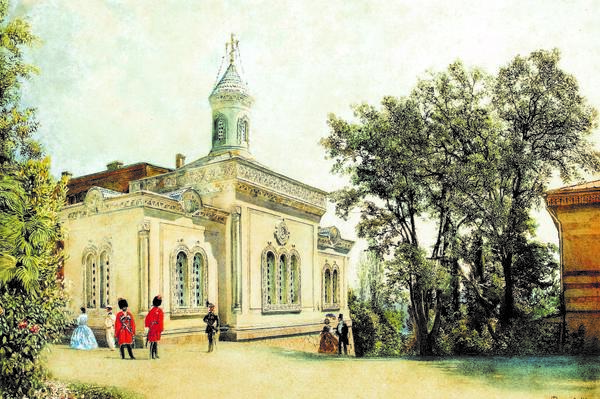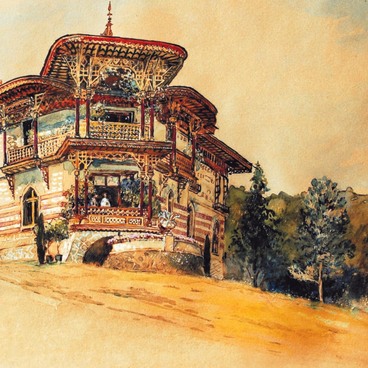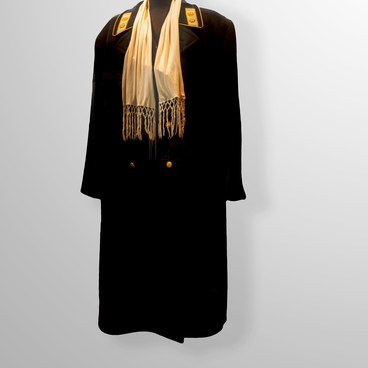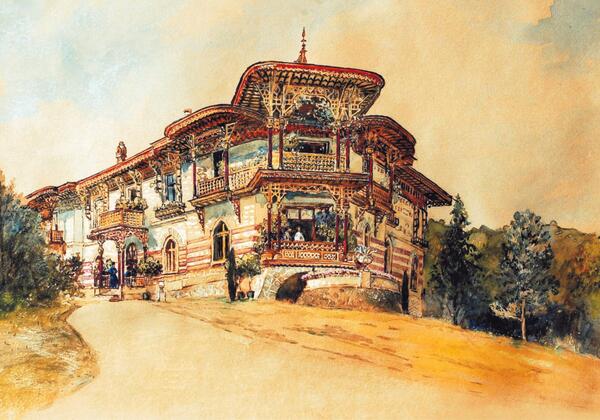The bedchamber of Their Imperial Majesties in the Livadia Palace is adorned by “View of the Church in Livadia” — a watercolor painting by Rudolf von Alt.
This watercolor piece depicts the northwest view of the royal family chapel in Livadia. The walls of the one-story church are embellished with carvings; the molded projecting cornice is crowned with a sloping roof, topped with a tower and a cross. A group of people, women and men, is in front of the church. The men are wearing either plain or military clothes. On the right side is a corner of a one-story building with a wooden cornice in the Tatar style. A few broadleaf trees grow between the building and the church. The roof of the old Grand Livadia Palace can be seen from behind the church.
Rudolf von Alt (1812–1905) was an Austrian painter and watercolorist, born into the family of the famous painter Jacob Alt in Vienna. He first studied under his father, then entered the Academy of Fine Arts Vienna. Alt inherited his father’s “meticulous technique, steady hand and respect for the truth, ” which were characteristic of panoramic mapping. Alt traveled extensively in the Austrian Alps and Italy. He stayed and worked for a while in Rome and Naples; after that, he visited the lakes of Lombardy, then Galicia, Bohemia, Dalmatia, and Bavaria. It was during those trips that the artist discovered his penchant for landscapes. In 1863, Alt came to Russia and visited Crimea. In Livadia, the artist created a large series of paintings where he thoroughly conveyed the architectural characteristics of the late 19th-century buildings of the Imperial estate.
The church depicted in the painting was founded by Empress Maria Alexandrovna, the wife of Alexander II. The Empress chose a talented Saint Petersburg architect Ippolit Antonovich Monighetti (1819–1878) to design and supervise the construction work, as she completely trusted his taste. The main wish of Empress Maria Alexandrovna was to enlarge the house of Count Lev Severinovich Pototsky, the previous owner of the estate, turn it into a large Imperial palace, and make the family chapel a separate building.
This watercolor piece depicts the northwest view of the royal family chapel in Livadia. The walls of the one-story church are embellished with carvings; the molded projecting cornice is crowned with a sloping roof, topped with a tower and a cross. A group of people, women and men, is in front of the church. The men are wearing either plain or military clothes. On the right side is a corner of a one-story building with a wooden cornice in the Tatar style. A few broadleaf trees grow between the building and the church. The roof of the old Grand Livadia Palace can be seen from behind the church.
Rudolf von Alt (1812–1905) was an Austrian painter and watercolorist, born into the family of the famous painter Jacob Alt in Vienna. He first studied under his father, then entered the Academy of Fine Arts Vienna. Alt inherited his father’s “meticulous technique, steady hand and respect for the truth, ” which were characteristic of panoramic mapping. Alt traveled extensively in the Austrian Alps and Italy. He stayed and worked for a while in Rome and Naples; after that, he visited the lakes of Lombardy, then Galicia, Bohemia, Dalmatia, and Bavaria. It was during those trips that the artist discovered his penchant for landscapes. In 1863, Alt came to Russia and visited Crimea. In Livadia, the artist created a large series of paintings where he thoroughly conveyed the architectural characteristics of the late 19th-century buildings of the Imperial estate.
The church depicted in the painting was founded by Empress Maria Alexandrovna, the wife of Alexander II. The Empress chose a talented Saint Petersburg architect Ippolit Antonovich Monighetti (1819–1878) to design and supervise the construction work, as she completely trusted his taste. The main wish of Empress Maria Alexandrovna was to enlarge the house of Count Lev Severinovich Pototsky, the previous owner of the estate, turn it into a large Imperial palace, and make the family chapel a separate building.




